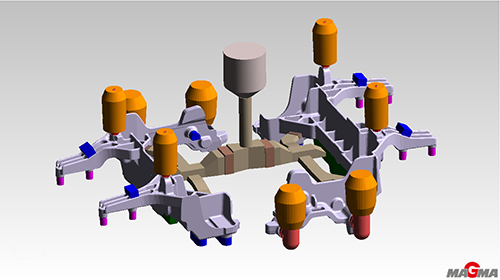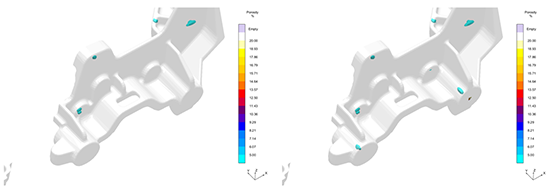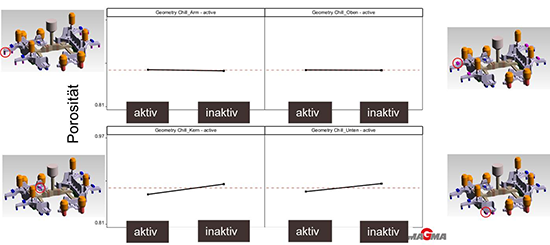Evaluate the Effectiveness of Casting and Feeding Systems
When laying out the rigging system, a common question is how to evaluate the effectiveness of the measures taken. What effect, for instance, does choosing a larger feeder or changing the position of a chill have on the feeding process? By systematically making use of virtual designs of experiments, it is possible to answer these questions.
In Figure 1, you can see the rigging system of a ductile iron casting (EN-GJS-400) with possible positions of the chills and feeders including different feeder sizes. The simulation of a virtual test field does not only provide you with information about the best chill layout, feeder size and position, but also allows you to see which effect the varied variables have on the casting quality.
Figure 2 shows the calculated porosity in a specific casting section. To the right, you can see the worst variant from the virtual test field, whereas to the left, you see the best variant. For reliably achieving the quality or systematically improving it, information about which measures have which effect on the result is very valuable.
Instead of using 3D results, it is also possible to visualize all pieces of information of the virtual design of experiments using statistical methods, such as the main effects diagram (Figure 3). The influence of four chills on the porosity of the casting is shown here as an example. In each case, two different situations are considered: “chill active”, that is, a chill is available, and “chill inactive”, that is, no chill is available. If the line runs horizontally, the chill has no effect on the porosity. If the line has a slope, however, this indicates an effect. Changing the chill size and/or position will result in a change of the casting quality.
The systematic evaluation of the main effects supports the foundryman in identifying those rigging system changes that have the maximum impact on the process and, thus, on the quality. It is a valuable tool for achieving the most effective quality improvements with the least possible effort.
If you are interested in learning how to better evaluate simulation results, we invite you to attend the seminar Evaluation of Simulation Results with MAGMASOFT® – Focus: Sand Casting/High Pressure Die Casting.
This interdisciplinary event is primarily aimed at executives and people in charge from design, quality and purchasing departments, who do not use the software for their work on a daily basis, but need simulation results for decision-making.
If you are interested in the seminars, we will be happy to submit a detailed offer. Please contact us by phone at +49 241 88 901 99 or by e-mail to academy@magmasoft.de.
We look forward to receiving your application under jobs@magmasoft.de!
If you are applying by post, please send your application to the following address:
MAGMA GmbH
Kackertstr. 16-18
52072 Aachen
Germany


